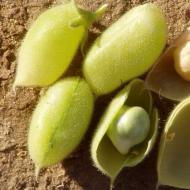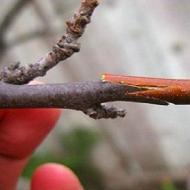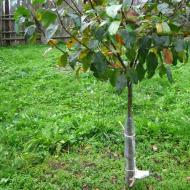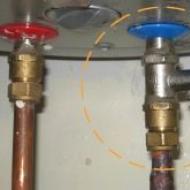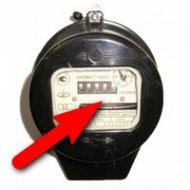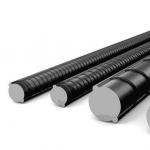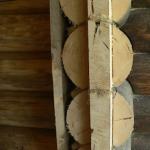
Siderat Field peas (pelyushka). How to collect field peas Biological features of peas
Botanical characteristics of peas
Peas belong to the Fabaceae family, genus Pisum. In culture, a common species is cultivated pea (Pisum sativum). It includes several subspecies, the main of which are common peas - with white flowers and light seeds, and field peas - often with speckled seeds. Field pea - forage plant with red-violet flowers and dark angular seeds, it is less demanding on soils, can grow on sandy soils . The genus Pisum does not differ in the variety of forms compared to other cultures. However, its classification has changed many times.
According to the old classification, recognized by P. M. Zhukovsky, all forms of peas were assigned to two species - sowing peas (P. sativum L) and field peas (P. arvense L). However, this classification has been repeatedly revised.
According to R. Kh. Makasheva, the genus Pisum L. consists of the following species: P. formosum - beautiful pea (the only perennial species that grows wild in the mountains); P. Fulvum - red-yellow pea (known in the wild); P. Syriacum – Syrian pea (in wild flora) and P. sativum – common pea (cultivated and wild forms).
Common peas are cultivated mainly. According to the modern classification, the sowing subspecies is ssp. sativum consists of several groups of varieties (convar).
The main groups of varieties of grain peas: convar. vulgare - common, convar. sativum - sowing and convar. mediterranicum - Mediterranean; vegetable: convar. melileucum - honey-white and ruminatum - ruminated; stern: convar. speciosum - beautiful.
Peas are characterized by a tap root system that penetrates the soil up to 1.0–1.5 m, with a large number of lateral roots, which are located mainly in the upper fertile layer. It is here that up to 80% of the plant's root system is concentrated. On the roots, in the nodules, there are nitrogen-fixing bacteria. They are contained in the soil or in fertilizers (nitragin, rhizotorfin), which are used to treat seeds before sowing, if peas are sown in this area for the first time. These nodule bacteria have the ability to absorb nitrogen from the air and synthesize physiologically active substances, including B vitamins.
The stem of the pea is round, indistinctly tetrahedral, hollow inside, usually decumbent, of various heights (below 50 cm - dwarf forms; 51–80 cm - semi-dwarf forms; 81–150 cm - medium length; more than 150 cm - high), depending on the soil- climatic, weather conditions and cultivation technology.
The leaf is complex, has a petiole, 2–3 pairs of leaflets, a pair of antennae (3–5, sometimes up to 7), which are modified leaflets. The sum of leaflets and tendrils is relatively constant. With the help of antennae, it clings to any support that allows the stem to grow in an upright position.
Peas can have several types of leaves: paired, pinnate or acacia (more than 6 leaves). They rarely have antennae, but if not, then the leaf may be leafless or whiskered, and then it consists of a cutting that passes into a multiply branched main vein, ends with antennae, there are no leaves.
The inflorescence is a brush, and in fasciated forms it is a false umbrella. On the peduncle of the lower fertile node, a bud first appears, and then a flower opens. This process goes from bottom to top along the plant and is extended in time, and therefore there are buds and flowers at the same time.
Flowers with double perianth. The corolla is of the moth type and consists of 5 petals: a sail or flag (reversely wide-ovoid or narrowed, as if cut off in the lower part), two oars or wings (elongated crescent-shaped) and a boat formed as a result of fusion of 2 petals.
The color of the corolla in grain and vegetable varieties is white, while forage and green manure varieties are pink of varying intensity: red-purple, red-violet, greenish-red-violet and rarely white. The sail is painted weaker than the wings. The color of the flower is determined by the wings.
Calyx is bell-shaped, joint-leaved, swollen on the upper side, with 5 teeth (2 upper ones are much wider than 3 lower ones). Forms with colored rim have anthocyanin pigmentation.
The flower has 10 stamens (one free and 9 fused to half into a stamen tube). Ovary nearly sessile, with up to 12 ovules;
Pea fruit - bean, consists of two wings with three to ten seeds.
Seeds are round, angular-round, oval-elongated, spherical, flat or irregularly compressed. The surface is smooth, sometimes with fine-meshed wrinkling of the seed coat or small pits on the cotyledons, wrinkled. The color is light yellow, yellow-pink, less often green, orange-yellow (waxy), monochromatic brown with a single (purple mottling, spotting or brown marbling) or double (brown marbling in combination with purple mottling or spotting) pattern. Thickness, width and length in the range of 3.5–10 mm. The weight of 1000 seeds is 100…350 g depending on the variety and cultivation conditions.
Depending on the presence of the so-called parchment layer in the bean shells, which usually consists of 2-3 rows of lignified and 1-2 rows of non-lignified cells, peeling and sugar or vegetable forms of peas are distinguished. Shelling varieties of peas crack when dry, sugar (vegetable) varieties do not crack and are more difficult to thresh. They are often used whole (green) beans.
The shape of the beans of the shelling group is varied: straight, slightly curved, curved, saber-shaped, concave, sickle-shaped. In the sugar group of varieties, in addition, they distinguish bead-shaped (the valves are narrow, tightly fit the seeds) and xiphoid (the valves are wide, much larger than the diameter of the seeds of the form). The shelling and sugar groups of peas are easily distinguished by their green beans. Beans of the sugar group (without a parchment layer) are easily broken (even dry), and shelling beans with a parchment layer are more difficult to break.
In general, peas are an early ripening leguminous crop with a growing season of 70–140 days. Peas are self-pollinating crops, but cross-pollination occurs during hot, dry summers. Nitrogen-fixing bacteria on the roots begin to form 7–10 days after germination, and during the period from flowering to ripening, their intensive growth occurs. When cultivating peas, it is necessary to take into account such features as a lodging stem, as well as extended periods of flowering and ripening. In many varieties of peas, the fruits crack when ripe. These shortcomings are overcome both by agrotechnical methods and by selection.
Biological features of peas
Light requirements.
Peas are long-day plants. Varieties of early ripening almost do not react to the shortening of the day. Most of the pea varieties cultivated in our country are long-day plants, so the period from germination to flowering passes more quickly in the northern regions. But the flowering period - ripening in years with excessive moisture and low air temperature, as a rule, is delayed.
heat requirements.
Peas are a light-loving culture of a long day; with a lack of light, a strong inhibition of plants is observed.
It is relatively cold-resistant and relatively undemanding to heat. The sum of effective temperatures during the growing season is 1150–1800°C. Seeds germinate at 1–2°C, but seedlings appear on the 20th day, often weakened. The optimum temperature is 4–5°C; at 10°C, seedlings appear in 5–7 days. Shoots easily tolerate short-term frosts up to 4-5 degrees, which allows you to sow peas in the early stages; during the fruiting period, temperature drops to minus 2–4 ° C are detrimental. The optimum temperature during the formation of vegetative organs is 14–16°С, during the formation of generative organs 18–20°С, for the development of beans and seed filling 18–22°С. If peas are sown at 20–25°C, then seedlings appear on the 4th–5th day.
For the normal development of seedlings, a temperature of 5 ° C is sufficient. Seedlings of most varieties tolerate frosts down to -4 C. All this indicates the possibility and expediency of sowing peas in the early stages.
Vegetative organs are well formed at a low temperature (12...16 C). Heat requirements increase during the period of fruit formation (up to 16...20 C), and during the growth of beans and seed filling - up to 16...22 C. Hot weather (above 26 C) is unfavorable for crop formation. The sum of active temperatures of the most common varieties during the growing season is only 1200 ... 1600 C, which is why the range of peas in our country is so wide.
moisture requirements.
Peas are demanding on moisture, responsive to irrigation, the transpiration coefficient is 400–500. Soil moisture should not fall below 70-80% of the lowest moisture capacity. In high-yielding varieties of peas, the transpiration coefficient is 500–1000, which is 2 times higher than that of grain crops. The critical period in relation to moisture is the period of flowering - fruit formation.
For swelling and germination, 100 ... 120% of water is needed from the dry weight of seeds, i.e. 2–2.5 times more than for cereals. The need for moisture in peas gradually increases as it grows and reaches its greatest value by the beginning of flowering. Peas tolerate excessive moisture satisfactorily, but at the same time, the growing season is delayed. Lack of water reduces the yield of pea grain. Therefore, all agrotechnical measures, especially in arid regions, should be directed to the maximum accumulation of moisture in the fields. Early sowing in a moist layer of soil with a leveled field surface creates conditions for rapid, uniform swelling of seeds and the appearance of friendly seedlings. The lack of moisture in the soil, as noted in a number of works, leads to minimal formation of nodules on pea roots. With a decrease in soil moisture to 40% or less (HB), i.e. below the moisture content of capillary rupture, the formation of nodules is significantly slowed down, their “reset” is observed, respectively, the number and mass of nodules are significantly reduced, and as a result, the active symbiotic potential decreases.
During the periods of budding, flowering and setting of beans, peas need moisture, the lack of water at this time causes the flowers and ovaries to fall off. Variation in the yield of peas is mainly due to the variability in the number of beans formed per unit area. Favorable moisture conditions during this period are especially important for the formation of a high yield.
soil requirements.
Peas make high demands on soils. The best soils for peas are medium-bound chernozem loams and sandy loams with a neutral or close to neutral reaction of the soil solution. Dense, clayey, swampy, and light sandy soils are of little use.
It germinates well on fertile soils, where soil density = 1.2 g/cm³, on chernozem, gray forest and cultivated sod-podzolic soils of medium granulometric composition, characterized by good aeration. On acidic and heavy floating soils, the symbiosis with nitrogen-fixing microflora is weakened and plants experience nitrogen starvation. Soils with high acidity (pH below 4.5) are unfavorable for peas. Peas grow well at pH = 7–8.
Peas take out a large amount of nutrients (from 1 t - 45–60 kg of nitrogen, 16–20 kg of phosphorus, 20–30 kg of potassium), therefore it is recommended to apply mineral fertilizers in a ratio of 1: 1: 1.5. Due to the ability of many varieties to develop quickly, this crop can be used in a busy fallow and in intermediate crops. Like other pulses with feathery leaves, peas do not bring cotyledons to the surface, so relatively deep seeding is possible.
Phases of growth and development of culture.
Peas are the most early-ripening grain legumes. The growing season ranges from 65 to 140 days. Self-pollination occurs in the closed flower phase, but in years with hot, dry summers, open flowering occurs and cross-pollination can occur. The flowering phase lasts 10–40 days. Vegetative growth proceeds most intensively from budding to flowering. The growth of green mass reaches a maximum during the period of fruit formation. Root nodules are formed when 5–8 leaves are formed on the plant (1.5–2 weeks after germination). Maximum nitrogen fixation was noted during mass flowering.
The growth rate of peas depends on varietal characteristics, on conditions of temperature, humidity and the availability of nutrients.
In pea plants, the phases of germination, budding, flowering and maturation are noted. The last phases are marked by tiers, since flowering and ripening occur sequentially from the bottom up the stem. At the same time, generative organs located on different tiers are at different stages of organogenesis.
In the growing season of peas, the initial and final stages are distinguished, when there is no photosynthesis: the first stage is sowing - seedlings and the second is ripening, when the leaves are completely yellowed and the seeds have already been filled, but the moisture content in the seeds is still high.
From germination to the beginning of ripening, four periods are distinguished in the development of peas, each of which is characterized by qualities important for the formation of the crop.
The first period (from germination to the beginning of flowering) lasts 30–45 days for peas, depending on the variety and environmental conditions. At this time, the density of plants is determined. At first, the leaf surface grows slowly, and then faster and faster, nodules form and function.
The second period (flowering and fruit formation) lasts 14…20 days. At this time, the leaf surface and biomass rapidly grow, continue and by the end of the period, the growth of plants in height is completed, flowering and fruit formation occur simultaneously. At the end of this period, the maximum leaf area is noted and the main indicator is formed that determines the future harvest - the number of fruits per plant and per unit area. This is a critical period in the formation of the crop, when due to lack of moisture, low symbiosis activity or other limiting factors, fruit set may decrease.
During the third period, the growth of fruits occurs, which by its end reach their maximum size. At this time, the number of seeds per unit area is determined. Daily increments of biomass are high, as in the second period. At the end of the third period, the maximum yield of green mass during the growing season is noted. In the second and third periods, sowing as a photosynthetic system functions with the greatest intensity. At the same time, plants, especially tall ones, lie down.
In the fourth period, seed filling occurs. There is an outflow of plastic substances, especially nitrogen, from other organs into the seeds. The increase in seed mass is the main process of this period, which completes the formation of the crop. During this period, such an element of productivity as the mass of 1000 seeds is determined. Then the sowing enters the ripening period, when the moisture content of the seeds gradually decreases. Depending on the variety and cultivation conditions, the growing season can be 70 ... 140 days. Due to the ability of many varieties to develop quickly, this crop can be used in a busy fallow and in intermediate crops. Like other legumes with pinnate leaves, peas do not bring cotyledons to the surface, so relatively deep seeding is possible. Pea is a self-pollinating plant; in hot weather, partial cross-pollination of a small number of plants is possible, but spatial isolation is not required when growing it for seeds.
tillage
In all soil-climatic zones of Ukraine, the system of basic tillage for peas should provide for its maximum cleaning from weeds and leveling the field.
The main tillage should include stubble breaking and plowing. After early plowing, especially in the southern regions, as weeds appear, one to three cultivations with harrowing are carried out to level the surface, loosen the soil and destroy weeds. On slightly weedy soils, before plowing, one stubble plowing is carried out to a depth of 7–8 cm with a disk cultivator LDG-15. In the event of the appearance of root-weed weeds (field spurge, field thistle, field bindweed), after two weeks, a second peeling is carried out with share tools to a depth of 10–12 cm, and then plowing with plows with skimmers.
The greatest effect in the fight against root weeds after early harvested predecessors (winter, early spring grains, corn for silage) is achieved by combining tillage with the use of decoctions or tinctures (vegetable extracts), which is very important in ecological and biological cultivation technology. The order of work is the following. The fields after harvesting are immediately peeled to a depth of 10–12 cm. After the mass appearance of weed rosettes (after 10–15 days), they are re-treated, and 12–15 days after such treatment, chiselling is carried out.
If the field is littered with rhizomatous weeds, the tillage system should be different: disking along and across with heavy disc harrows BDT - 7.0 to a depth of 10–12 cm weed..
In the steppe regions of Ukraine, where a significant part of pea crops is placed after corn for grain, to ensure a higher quality of plowing, the fields after harvesting the predecessor should be treated with heavy disc harrows. This allows you to better grind and embed root residues in the soil.
The depth of plowing for peas depends on local conditions. On chernozems infested with perennial weeds, plowing to 25–27 cm should be practiced. In other cases, it is necessary to plow 20–22 cm, 18–20 cm, or to the depth of the arable layer.
In areas subject to wind erosion, with a long warm post-harvest period, layer-by-layer tillage is carried out, including 1–2 stubble loosening with flat cutters KPSh-9 to a depth of 8–10 cm and one deep loosening with flat cutters KPG-2–150, KPG-250 for 22– 25 cm.
In areas where summer droughts often occur, pea yields are more dependent on the reserves of productive moisture accumulated at the time of sowing. Therefore, in winter, on the areas allotted for peas, it is necessary to carry out snow retention in order to accumulate as much moisture in the soil as possible.
The main goal in pre-sowing tillage for peas is to create a well loosened, finely cloddy soil layer to a depth of 8-10 cm and to perfectly level the field. Deviation from these technology requirements in terms of the depth and quality of loosening adversely affects the observance of the optimal depth of seed placement, and the unevenness of the field predetermines crop losses during harvesting.
For pre-sowing tillage and sowing, caterpillar tractors DT-75M, T-4A and wheeled tractors of the MTZ-80, 82 type should be used: they compact the soil less. Energy-saturated tractors K-701, T-150K, having a high specific pressure of the wheels on the soil, should be used only in extreme cases.
Peas should be sown as early as possible - as soon as the soil ripens. This rule must be observed in all major areas of crop cultivation. With early sowing, pea plants use the autumn-winter moisture reserves in the soil more productively. The gap between pre-sowing tillage and sowing should be minimal. The smaller it is, the higher the quality of sowing.
Pea seeding rates used in different zones of the country are different. They range from 0.8 to 1.4 million germinating seeds per hectare and depend on many factors: soil texture, climate, sowing time, variety characteristics, planned crop care operations. For grain varieties of peas on light soils, the norm of germinating seeds is 1 million pieces/ha, and on heavy soils 1.2 million pieces/ha.
When cultivating long-stemmed cutting varieties for seeds, the optimal rates of germinating seeds are 0.8–0.9 million pieces/ha. In the Central Black Earth zone of Ukraine, the seeding rate is 1.2–1.4 million units/ha, in the conditions of the Crimea - 1 million germinating grains per ha (250–270 kg/ha). If two or three times harrowing of crops is envisaged, the rate should be increased by 10 - 15%. When setting the seeders to the seeding rate, it is necessary to ensure that the length of the working part of the sowing machine coils is the largest, and the speed of their rotation is the smallest.
Particular attention should be paid to the depth of embedding pea seeds in the soil. For swelling and germination, they require water in an amount of 100–120% of their mass. Since the top layer dries out quickly after pre-sowing treatment, sufficient moisture is provided only with deep seed placement. With shallow incorporation, especially in dry weather, field germination is sharply reduced, the root system develops worse, and plant damage increases when crops are harrowed. The optimal seeding depth is 6–8 cm. On light soils or under conditions of rapid drying of the upper layer, it is increased to 9–10 cm. And only on heavy soils is it possible to sow to a depth of 4–5 cm.
Sowing should be done with row seeders (SZ - 3.6, SZA - 3.6, SZP - 3.6), as they are deeper than narrow-row ones, cover the seeds and clog less on wet soil. For better penetration of the openers into the soil in the tracks of tracks or wheels of tractors DT-75, MTZ of all modifications and YuMZ, it is advisable to install a ripper on the lower links of the rear linkage mechanism. It is a beam and hinged sections of the working bodies from the KRN-4.2 cultivator with chisels for loosening the soil compacted by the tractor. Light or medium harrows are installed on the hitch in the tracks of wheels or caterpillars to level the surface behind the ripper. In order to ensure a large depth of the coulters, increase the pressure of the springs on the rods. For the same purposes, the speed of movement of the sowing units should not exceed 5–6 km/h.
In dry weather, after sowing, it is necessary to roll with ZKSH-6 ring-spur rollers. This helps to pull moisture into the upper layers of the soil and provides more friendly early shoots. The soil surface remains quite loose and swims less when it rains.
Weeds can cause great damage to peas. The grain yield from overgrowing of crops with weeds is reduced by 30–40%. The simplest effective method of weed control is crop harrowing. With one pre-emergence harrowing and one or two on seedlings, it is possible to destroy up to 60–80% of annual weeds. In addition, it eliminates the crust, loosens the soil well, and reduces moisture loss. Harrow only in dry weather. Before germination, the soil is loosened four to five days after sowing, when the weeds are in the phase of white threads, and the roots have begun to form in the pea seeds, but the stalks have not yet appeared. Harrowing on seedlings of peas is carried out in the phase of three to five leaves, with mass germination of weeds in the daytime, when the plants lose turgor. When the tendrils of plants are linked, harrowing is stopped. Processing is carried out only across the rows or diagonally, with harrows with well-drawn sharp teeth. In this case, the bevel of the teeth should be directed towards the movement of the unit, and the speed should not exceed 4–5 km/h. Usually, on light soils, light harrows ZBP-0.6A or mesh BSO-4A are used, and on medium and heavy soils, medium tooth harrows BZSS - 1.0. In units for harrowing, a tractor DT-75 or MTZ - 80 and a hitch SG-21 are used, thereby reducing the specific pressure on the soil of the wheels and tracks of the tractor.
Harvesting is the most complex operation in pea cultivation technology. Before it, neither retardants nor other chemicals that stimulate and accelerate the ripening of pea beans are used.
It has been established that the accumulation of dry matter by pea plants is completed, depending on weather conditions, with an average grain moisture content of 40 to 57%. The grain harvested during these periods after ripening in rolls reaches its maximum mass. In wet years, the filling of grain ends, as a rule, at a higher level of humidity - 50–70%.
The best sowing qualities of seeds were obtained by mowing peas with a grain moisture content of 40–45%, 35–40%, when the number of ripe beans reaches 60–80%. This period provides a more reliable preservation of the sowing qualities of seeds during ripening in rolls, and it can be recommended as the optimal period for separate harvesting of pea crops.
The optimal duration of the harvesting period is three to four days. With such terms of work, the maximum yield and minimum losses are ensured, high quality seeds are obtained. Pea harvesting is carried out by harvesters ZhRB - 4.2, mowers KS - 2.1 with devices PB - 2.1 and PBA-4 ..
High-quality seeds of the Damir 3 pea variety released in the Crimea were used as seed material in the research. In the Register of Plant Varieties of Ukraine - since 2000. Damir 3 variety due to such properties and characteristics as cold resistance (withstands frosts down to -6, -8 Cº in the phase 3–5 leaves), short stem (plant height 50–70 cm, first internodes shorter than in long stem varieties by 2–3 times, number of internodes – 13–14, up to the first inflorescence – 8), strength and density of stems , the presence of a large number of tendrils (increased adhesion of plants with tendrils is observed already in the period of formation of 6–8 leaves), a high yield index (grain-to-straw ratio) is the most technologically advanced. Variety of peas of mustachioed type, high standard. Plant length is medium to long. The first internodes are shorter than in long stem varieties, the number of internodes is 13–18. It is characterized by good strength and density of stems, as well as the presence of a large number of tendrils, which leads to good adhesion of plants. Lodging resistance is high.
Such properties of Damir 3 peas determine its suitability for a progressive harvesting method - direct combining.
The pea variety Damir 3 is drought-resistant, resistant to lodging and diseases (peronosporosis, ascochitosis, root rot). Beans (9-11 pieces, maximum 15 pieces) are concentrated in the upper part of the plants, ripen almost simultaneously. The growing season is 80–90 days. Shatter resistance is high. Weight of 1000 grains 250–270 g. Protein content 24.6–26.5%. The maximum yield in Ukraine is 48.9 q/ha.
Elements of agricultural technology
Predecessors - grain cereals, sugar beet, corn.
The sowing date is the earliest for the region.
The seeding rate is 1.1–1.2 million germinating grains per 1 ha.
Sowing depth - 5-7 cm.
Rolling crops.
Chemical protection against weeds and pests with recommended preparations.
Pea fertilizer
The experience of many years of research around the world shows that more than half of the increase in crop yields due to scientific and technological progress in production is provided by the use of fertilizers. Today, in the context of the economic crisis in production, they are trying to save money on fertilizers or refuse to use them at all, which entails a decrease in grain yields to 13–16 centners per hectare. Nutrient intake occurs during the growing season with varying degrees of intensity.
Nitrogen is absorbed by plants over a long period - from germination to ripening, but its greatest amount is during budding - fruit formation. According to Yu. A. Chukhnin, during the period of flowering - fruit formation, about 37–40% of nitrogen from its total consumption is absorbed.
The maximum nitrogen content in plants usually falls on the flowering phase, i.e. when its fixation by nodule bacteria is most intensive. After flowering, the relative nitrogen content decreases slightly. During the filling period - seed ripening in plants, nitrogen is redistributed - it decreases in leaves and stems and increases in beans. In peas, the accumulation of nitrogen due to fixation from the atmosphere, depending on growing conditions, ranges from 42 to 78% of the total consumption of this element from the environment.
Phosphorus in the greatest amount enters plants in a relatively short period of time - from flowering to seed ripening. During this period, plants absorb 60–62% of phosphorus from its total content in the plant, and symbiotic fixation of atmospheric nitrogen contributes to good absorption of phosphorus. Peas are characterized by a high ability to absorb phosphorus from hard-to-reach soil compounds. A good supply of potassium increases the use of phosphorus reserves in the soil. According to the same data, the highest content of phosphorus in plants is observed at a young age (seedling phase - 6–7 leaves), by flowering its content decreases, and again slightly increases in the fruiting phase. Mature seeds contain 2.5–3 times more phosphorus than straw.
Potassium, unlike nitrogen and phosphorus, is most intensively absorbed in the early phases of the growing season. By the beginning of flowering, pea plants absorb up to 60% of potassium from its total consumption. The content of potassium in plants gradually decreases from early age to maturation. In seeds and straw, the content of potassium is almost the same. Potassium deficiency, which manifests itself mainly on light soils, causes a decrease in nitrogen fixation and impairs the movement of nitrogenous substances from vegetative organs to seeds. Therefore, phosphorus and potash fertilizers should be applied in autumn before plowing. They improve the development of plants and enhance the activity of nitrogen-fixing bacteria. Calcium plays an important role in plant life. With its lack, growth rates decrease, the development of the root system worsens. Unlike nitrogen, phosphorus and potassium, the calcium content in plants increases towards the end of the growing season.
It is known that nodule bacteria develop well on cultivated soils with a neutral or slightly acid reaction of the medium and with a high supply of phosphorus, potassium and molybdenum.
In a number of works, the positive effect of phosphorus and potash fertilizers on leguminous crops, and in particular on peas, was noted. Their joint use of 40 - 60 kg a.i. each per 1 ha of gray forest soils or leached chernozems increases the protein content in pea grain by 1–2% and crop yield by 2–3 c/ha.
Microelements, especially molybdenum, play an important role in the life of nodule bacteria. It is part of such enzymes as nitrate reductase, nitrite reductase, etc., which are actively involved in the fixation of molecular nitrogen by nodule bacteria, in the reduction of nitrates to ammonia, and in providing plants with it.
In various literary sources, it is recommended to carry out seed inoculation (the use of nitragin), while the accumulation of proteins increases by 2–6% of the seed weight. The greatest effect from infecting legume seeds with nitragin is obtained on well-cultivated, non-weedy soils, on calcareous or non-acidic podzolic soils fertilized with manure or phosphorus-potassium fertilizers. Nodule bacteria are demanding on moisture, therefore it is necessary to sow inoculated seeds in the best agrotechnical terms, preventing the soil from drying out. The use of nitragin is more effective in areas of sufficient moisture or when irrigated in dry conditions. The activity of nitragin sharply weakens with time, and therefore it must be used in the year of production.
Academician I. S. Shatilov in his research shows that the maximum consumption of nutrients by peas does not fall on the period of full seed ripeness, when we calculate the removal of nutrients with the harvest, but on earlier phases of vegetation. In his studies, the maximum consumption of nitrogen exceeds the removal with a crop by 32.7–37%, phosphorus by 34–39.7%, potassium by 66.3–70%, calcium by 32.4–37.8% and magnesium - by 50.7–58.5%. In accordance with this, Academician I.S. Shatilov recommends that the calculation of fertilizer doses for a given pea crop be carried out not according to the removal, but according to the maximum consumption of the main elements of mineral nutrition.
According to A. A. Ziganshin, not only the presence of nutrients in the soil, but also their content in a certain ratio, corresponding to the biological requirements of the culture, is important for peas. On fertile soils, the desired ratio between nitrogen, phosphorus and potassium (N:P:K) is 1:1:1.5.
Peas use nitrogen unevenly during the growing season. Under favorable conditions for leguminous rhizobium symbiosis, most of the nitrogen (70–75% of total consumption) can be obtained by plants as a result of symbiotic air nitrogen fixation. In this case, peas do not need the use of nitrogen fertilizers; for the initial development, it uses the nitrogen of the cotyledons and soil.
A number of studies have established an improvement in the formation of legume-rhizobium symbiosis with greater nitrogen-fixing activity by introducing rhizospheric bacteria of the genus Pseudomonas. Inoculation of legumes with Pseudomonas increases the yield and the amount of nitrogen in the plants. The greatest increase in the mass of pea plants, including grain, as well as the removal of nitrogen by the crop, was found during complex inoculation with nodule bacteria R. leguminosarum and Pseudomonas bacteria in comparison with the associative diazotrophic bacterium Klebsiella.
Yielding mid-season fodder variety, mustachioed form, resistant to lodging and shedding of seeds. Record holder for protein content in grain (28.5%). The variety is resistant to stressful situations and adverse weather conditions. Suitable for mixed crops for green mass. Included in the State Register for the Volga-Vyatka, West Siberian and East Siberian regions of the Russian Federation.
Biological features
A variety of Cirrosum tenax. The variety was bred by the method of intervarietal hybridization "Orlovchanin 2" x "Nemchinovsky 817" with subsequent individual selection.
mustachioed leaf– a new form for feed peas! Formation of strong tendrils creates a woven stem, resistant to lodging and suitable for direct combining. The yield of green mass is 380-420 c/ha, which makes the variety universal in its use. The protein content in the green mass is 20-22%. Number of internodes 17-19. The beans are attached high - at the 14-17 knot.
- Maximum grain yield in production: 4.9 t/ha (2011 Tyumen region, Omutinsky district). Harvest in the state test: For three dry years 2010-2013. – 2.15 t/ha (Tyumen region, Yalutorovsk GSU), which is at the level of the standard.
- Lodging resistance: 4.4-4.7 points
- Weight of 1000 grains: 210-240 g
- Plant Height: 80-90 cm
- Vegetation period: 85-95 days
- Grain protein content: 28-28,5%
Features of the cultivation technology of the variety
Sowing date Seeding rate (germinating seeds per m2)
The earliest, tolerates early spring frosts
- 120-130 pcs/m2 - early sowing
- 130-140 pieces/m2 - late sowing
- Optimal seeding rate 1.3 million units/ha
- Sowing depth 4-6 cm (6-8 cm in conditions of moisture deficiency)
Harvest
At 16-18% humidity, mainly by direct combining, gentle mode of the combine and post-harvest work (drum speed 250-400 rpm).
Pests
The greatest danger is the nodule weevil pea aphid, codling moth and caryopsis
disease resistance
Highly resistant to diseases: Ascochitosis, Anthracnose.
Basic fertilization (taking into account the elements in the soil)
- Phosphorus, potassium – up to 50 kg/ha of a.i.
- Nitrogen (only on poor soils) - 20-30 kg/ha a.i.
- SZR - according to the generally accepted zonal farming system for the cultivation of peas. - at early terms of crops dressing is obligatory (Wincite is not bad);
- when aphids appear, work on the first generation without waiting for the second;
- the use of herbicides, depending on the infestation, allowed by the culture (Pulsar does not work badly, the disadvantages are expensive, a strict restriction on the development phase of peas.);
- when rust pustules appear on the lower tier of pea leaves, work with fungicides without waiting for spread (good effect Alto-super (0.4 - 0.5) Rex C (0.6 - 0.8).
Peas are cultivated mainly as a food crop. Its seeds contain up to 26% protein, are distinguished by good digestibility and high palatability. Green peas and unripe beans (vegetable varieties) of peas used in the canning industry contain up to 25-30% sugar, a lot of salts and vitamins (A, B1, B2, C).
Pea flour is used as a concentrate for animals, and pea - cereal mixtures - for the preparation of silage, grass meal, for green "fodder. In 1 kg of pea seeds 1.17 fodder. units and 180-240 g of digestible protein, and in 1 kg of green mass - 0.13 feed. units and 25 g of protein. Use for feed and pea straw containing 6-8% protein and up to 34% BEV, in I kg of straw - 0.23 feed. units and 31 g of protein.
With high agricultural technology, peas leave up to 50-70 kg / ha of nitrogen in the soil and can be a good predecessor of cereals and other crops. It is of no small importance as a fallow crop and as a green fertilizer (in irrigated agriculture and in the Non-Chernozem zone).
Peas are one of the most ancient crops, originating from India and Afghanistan. On the territory of our country (in the European part and on the territory of Belarus) it was cultivated in the 6th-8th centuries.
The total sown area of peas in the world is about 10 million hectares. Its crops are common in China, the USA, Canada, Western Europe and Australia. In the CIS, it is the main grain legume. Its crops reach 65 ° N. sh. and occupy an area of more than 4 million hectares (in the central part of the Non-Chernozem zone, the Tatar, Chuvash and Mordovian autonomous republics, in the Central Chernozem region, the Volga region, Western Siberia, the right-bank and forest-steppe parts of Ukraine, Belarus and the Baltic republics).
Botanical characteristic. Pea (Pisum L.) is represented by several species, of which the polymorphic species P. sativum L. is the most common - cultivated pea.
It is divided into subspecies: ssp. sativum - common pea and ssp. arvense - field peas (pelyushka), etc.
Peas Sowing (Fig. 18) has white flowers, green leaves, spherical smooth (sometimes wrinkled) seeds with a uniform color (white, green, pink) and light (rarely dark) scars.
The mass of 1000 seeds is from 150 to 300 g. This subspecies of peas is the most common in cultivation.
Field peas, or pelyushka, It has red-violet flowers, green leaves, stipules with purple (anthocyanin) spots.
Rice. 18. Sowing peas.
Seeds are round-angular, with small dents, with a brown or black scar. The peel is gray-green, brown or black, often with a mottled pattern.
Field peas are less demanding on soils and are common in the western and northern regions of the CIS, especially on sandy and peaty soils. It is cultivated for fodder purposes and as a green manure.
Biological features. Pea is a cold-resistant plant, relatively undemanding to heat. Its vegetation period, depending on the variety and conditions, ranges from 60 to 120 days. Peas are cultivated up to the northern borders of agriculture - 68 ° N. sh.
Seeds begin to germinate at a temperature of 1-2°C (brain and sugar at 4-5°C). Seedlings are able in some cases to withstand frosts down to -6...-8°C. In Transcaucasia and Central Asia, winter varieties are cultivated that can overwinter in mild winters. Feed varieties of peas (pelyushki) are more resistant to frost. At a temperature of -2-3 ° C during the fruiting period, unripe beans freeze slightly
Pea belongs to the light-loving plants of a long day, as a result of which its development is relatively accelerated in the northern regions. Peas are self-pollinating, but in dry and hot weather, cross-pollination is often observed. With a relatively weak root system, plants develop a large green mass in a short period. This partly explains the great demands of the crop on moisture and soil fertility. Peas make especially high demands on moisture before flowering. Flowering lasts 10-30 days, with drought - 6-8 days. The formation of root nodules begins with a phase of 5-8 leaves.
Best of all, peas succeed on highly fertile soils, in particular, on chernozems of medium cohesion, sufficiently moistened and rich in lime, as well as on gray forest and cultivated soddy-podzolic soils. It grows poorly on dense, heavy, light sandy, solonetzic and marshy soils with a close occurrence of groundwater (at a depth of 60-80 cm). Favorable soil reaction pH 6-7.
In terms of drought resistance, peas are superior to beans, vetch and lupine, but inferior to lentils, chickpeas and chin. Transpiration coefficient 400-589. The introduction of phosphorus and potassium reduces water consumption by plants by 6-10%.
In arid conditions, peas are best cultivated in low places, where they suffer less from drought. In the northern regions, crops should be placed on elevated areas with stucco soil.
In the development of a pea plant, the following phases are noted: shoots, budding, flowering and ripening. Due to the extended differentiation of generative organs (2-5 fruiting nodes formed at different times), it is difficult to focus on the stages of organogenesis.
Place in crop rotation. Peas should be allocated a good place, sown on fertilized predecessors. Depending on the zone, the precursors for peas can be: winter cereals, sugar beets, corn, potatoes, flax, spring wheat, barley, oats. Repeated sowing of peas in one place leads to a decrease in yield due to "pea fatigue" of the soil, the spread of damage by root rot, so peas can be returned to the field after 5-6 years.
Peas should not be sown after sunflowers (carrion is dangerous), grain legumes and perennial grasses (common pests are dangerous). Peas should be placed in a crop rotation so that the spatial isolation from perennial legumes is at least 500 m. Peas are a good predecessor for many crops - winter cereals, corn, spring grains and industrial crops.
Soil cultivation. The main tasks of soil cultivation are its cleansing from weeds and leveling.
The main processing includes stubble breaking and plowing. If root weeds appeared on the field, then 2 weeks after the first peeling, the second one is carried out to a depth of 10-12 cm, and then plowing with plows with skimmers.
Fields clogged with rhizomatous weeds are treated differently: disking is carried out along and across with heavy disc harrows BDT-7.0 to a depth of 10-12 cm and after the appearance of couch grass awl, plowing to a depth of 25-27 cm.
In areas prone to wind erosion, layer-by-layer tillage is carried out: 1-2 stubble peelings with flat cutters KPSh-9 per. a depth of 8-10 cm and one deep loosening with flat cutters KPG-2-150 by 22-25 cm. In arid conditions, it is necessary to carry out snow retention.
The tasks of pre-sowing tillage are the creation of a loosened (without clods) seed layer and field leveling, which is necessary for uniform sowing and improved harvesting conditions. Pre-sowing tillage includes harrowing to cover moisture and level the field with heavy bast harrows BZTS-1.0 and one cultivation to a depth of 8-10 cm with KPS-4 cultivators in an aggregate with medium harrows BZSS-1.0 across or diagonally to the direction of plowing.
During flat-cut tillage in autumn (Western Siberia, Northern Kazakhstan), moisture is closed with needle harrows BIG-ZA, pre-sowing loosening is carried out with a KPSh-9 cultivator.
Fertilizer. Peas are very responsive to the introduction of organic fertilizers under previous crops. Mineral fertilizers should be applied directly under the peas. High yields (3-4 t/ha) can only be obtained on highly fertile soils. On poorly cultivated lands, peas give low yields.
For the formation of 1 ton of seeds and the corresponding amount of straw, peas consume: 45-60 kg of nitrogen, 17-20 kg of phosphorus, 35-40 kg of potassium, 25-30 kg of calcium, as well as trace elements - molybdenum and boron.
A significant part of the need for nitrogen is met by peas with biological nitrogen, and therefore nitrogen is brought in about 1/3 of the removal, and it is desirable to give phosphorus more removal by 1.3-1.6 times.
Neutralization of soil acidity (by liming) improves the symbiotic activity of nitrogen-fixing bacteria and increases yields.
Growing peas on cultivated soils after fertilized predecessors with a content of available forms of phosphorus and potassium of more than 15 mg per 100 g of soil ensures the production of 3 t/ha of grain or more without fertilization.
On soils with a low content of humus (2%), as well as at low (less than 10 mg per 100 g of soil) and very low (less than 5 mg per 100 g of soil) content of phosphorus and potassium, it is necessary to apply phosphorus, potash and nitrogen fertilizers under peas . Phosphorus and potash fertilizers are used taking into account the planned harvest, and nitrogen fertilizers - taking into account the level of symbiotic nitrogen fixation. Phosphorus and potash fertilizers are applied under the main tillage, and nitrogen fertilizers - under pre-sowing cultivation.
Mandatory reception - introduction into the rows when sowing phosphorus - 10-20 kg / ha. In the Non-Chernozem zone, instead of superphosphate, it is better to use complex granular fertilizers as a row fertilizer. The dose of complex fertilizers applied to the rows should be 10-20 kg/ha of a.i. in terms of phosphorus.
To improve the conditions for symbiotic nitrogen fixation, it is necessary to use molybdenum and boron if they are less than 0.3 mg in 1 kg of soil. Granular molybdenized superphosphate is used as molybdenum fertilizer. It is applied when sowing in rows at a dose of 10 kg / ha (for phosphorus) or the seeds are treated with molybdenum preparations.
Boric fertilizers are most often used on acidic soddy-podzolic and gray forest soils after liming. Superphosphate enriched with boron is added to the rows. Boron is also used in seed treatment. It is better to apply one of the microfertilizers in rows with superphosphate, and the other with treated seeds.
Sowing. For sowing, sorted seeds of the first class of the sowing standard of zoned and promising varieties are used, not affected by the pea weevil.
Seed dressing is a mandatory method against ascochitosis, root rot, affinominosis, fusarium, anthracnose, as well as soil pests.
Peas are an early sowing crop, they are sown simultaneously with early spring grains. Early crops are less damaged by powdery mildew and aphids, root better and grow more intensively. The gap between pre-sowing treatment and sowing should be minimal.
With conventional row or narrow row sowing, 0.8-1.4 million viable seeds (150-350 kg/ha) are sown per 1 ha. In the Non-Chernozem zone, the Central Chernozem Zone, in Ukraine, the optimal rate is 1.2-1.4 million. Sowing peas in a wide row does not make sense, since its yield decreases from lodging, such sowing is more difficult to harvest.
For swelling and germination, pea seeds absorb 100-120% of water by weight of seeds, which is 2 times more than cereals. Therefore, pea seeds are sown deep - 6-8 cm into the moist soil layer (on light soils - 9-10 cm). With small sowing, field germination is greatly reduced. During germination, peas do not bring cotyledons to the soil surface.
For sowing, grain seeders S3-3.6, SZA-ZD SZP-3.6 are used. In areas where flat-cut tillage is adopted, the SZS-2.1 seeder is used.
Crop care. Immediately after sowing, the field is rolled with ZKKSH-6 ring-spur rollers. An effective method of weed control is pre-emergence and post-emergence harrowing in the 3-5 leaf phase (before tendril formation) during the daytime across the rows or diagonally. Usually, on light soils, stucco harrows ZBP-0.6A or mesh harrows BSO-4A are used. and on medium and heavy - medium-tooth BZSS-1.
Protection of plants from pests and diseases. Seedlings are treated with herbicides in accordance with industry regulations. Both edge treatments and continuous treatments are used for the mass distribution of pests. In the flowering phase, crops are treated against pea weevil, bean moth, pea codling moth, thrips. Apply drugs karbofos, metafos, phosphamide.
botanical name- peas (pisum), a genus of annual grasses of the legume family, subfamily of moths, a common vegetable, grain and fodder crop.
Origin- Western Asia, North Africa.
Lighting- light-loving.
The soil- neutral loamy, seasoned with humus for the previous crop.
Watering- hygrophilous.
predecessors- pumpkin, potatoes, cabbage, tomatoes.
Landing- seeds.
Classification and description of peas
The currently accepted classification of the plant takes into account the difference in the structure of the stem, the type of branching, the number of pairs of leaves, as well as the weight of the fruits and the distribution area, and divides the genus into 2 types of peas, red-yellow and sowing.
Red-yellow pea (Pisum fulvum Sibth) distributed in Asia Minor, is a low-growing plant with a thin stem, small (3-4 cm) beans and round small seeds with a diameter of 0.3-0.4 cm. It occurs only in the wild.

Peas (Pisum sativum L) - a very polymorphic species, in turn, is divided into 6 subspecies, each of which has many varieties and different economic importance. High peas (P. elatus) and Syrian peas (Pisum syriacum) are weedy field plants, Abyssinian peas (Pisum abissinicum), Transcaucasian peas (Pisum transcaucasicum) and Asian peas (Pisum asiaticum) are primitive cultivated crops. The most common subspecies, the field pea (Pisum ssp. Sativum), is grown everywhere as a fodder, vegetable, and green manure crop.

Sometimes another subspecies is distinguished - field peas (Pisum arvense), another name is pelyushka, used as a fodder plant.
Common pea is an annual herbaceous plant with a creeping, sometimes branching stem from 15 to 250 cm tall. Parapinnate leaves have 1-3 pairs, often with tendrils at the ends. Taproot, up to 1 m long, with characteristic nodules of nitrogen-fixing bacteria. Flowers, 1-3, sometimes 3-7 on peduncles, located in leaf axils. The color of the flowers is white, red, purple-violet. The fruit is a bean (pod) of a straight or curved shape, flat or cylindrical. Seeds, also called peas, are round, smooth or wrinkled, with a colorless, sometimes colored skin.
Pea is a plant with an ancient history. According to some reports, it was eaten by primitive people 10 thousand years ago. The first mentions and descriptions of peas are found in the 7th century BC. in northern Africa and southwestern Asia, which are considered its homeland.
5 centuries after that, the plant was brought to Russia, and already in the 11-12 centuries it was mentioned among grain crops along with rye, oats, and wheat. Sweet varieties, now known as green peas, were developed in the 16th century and quickly gained popularity in Europe and then in Russia. The plant was grown in private courtyards and vegetable gardens, its mass cultivation in the fields began in the 18th century.
Variety groups and common varieties of peas
Sowing peas, the photo of which is given below, is grown everywhere as a vegetable and grain crop. Its numerous varieties according to the structure of the bean are divided into two variety groups:
shelling peas, with a hard parchment layer of bean flaps, seeds are used for food, which in their mature form contain a lot of starch. Dry grains are well boiled, used for making soups, and at the stage of technical ripeness - for freezing and canning.

sugar peas with flaps without a parchment layer, sweet, tender, whole unripe pods are used for food. Mature seeds have a shriveled appearance due to the high moisture content of raw grains. Sugar varieties are demanding on cultivation conditions, more affected by diseases and pests.

Within both groups there are varieties with smooth round and wrinkled grains. The latter are called cerebral, have an angular square shape. They contain a lot of sucrose (up to 9%), little starch, and do not boil soft during heat treatment. Brain sweet peas are used in the canning industry, they produce the highest quality canned and frozen green peas.
According to their purpose, varieties of sowing peas are divided into table peas used to prepare various dishes, canned, immature grains of which are harvested in the form of green peas, and universal - they use both green peas and ripened seeds. In terms of ripening, early ones ripen 45-60 days after germination, medium ones, the growing season of which is 60-80 days, and late ones, ripening more than 80 days later.
Peeling grades:
Avola, mid-early (56-57 days), friendly ripening, recommended for canning, freezing, fresh use.

Adagum, mid-season (50-55 days). Sweet peas, with brain seeds, do not require supports, are used fresh and for the production of canned food.

Alpha, early variety (46-53 days), undersized, for canning purposes.

Vega, mid-early variety, medium height, cerebral, universal purpose.

Viola, mid-season (57-62 days), undersized, with brain seeds, canning.

Sunrise, mid-late, brain, canning purposes.

Premium, early-ripening, friendly ripening, used both fresh and for canning.

Early Gribovsky, one of the most precocious, undersized, high-yielding, universal purpose.

Troika, late variety (80-90 days), cerebral, medium height, universal.

Hava pearl, mid-season (54-70 days), suitable for fresh consumption and processing.

Sugar varieties:
Zhegalova 112, mid-season (60-80 days), with brain seeds, ripening together. Both spatulas and green seeds are used for canning.

Inexhaustible 195, mid-season (45-60 days), with timely harvesting of the blades, the second wave of the crop grows.

Oregon, medium early (55-65 days), high, up to 120 cm, requires support.

Sugar, early ripe, undersized, use shoulder blades for food.

Sugar 2, mid-season (55-60 days), resistant to lodging. Both blades and ripe seeds are used for food, both of which have excellent taste qualities.

Useful properties of peas
The beneficial properties of peas, like all legumes, are due to the high content of vegetable protein in it, in dry seeds up to 20%, which is absorbed by the human body by almost 70% and includes essential amino acids: tryptophone, cystine, lysine, methionine, etc. necessary for the formation of animal proteins.

Undoubtedly, the benefits of peas as a crop, in terms of energy value, are unparalleled among vegetables. The calorie content of dry seeds per 100 g of the product is about 300 kcal, almost 2 times more than that of potatoes. It is thanks to the combination of high protein content and calorie content that the plant has received the name "meat for the poor."
The beneficial properties of peas are not limited to this. It also contains sugars, enzymes, vitamins C, A, PP, group B, salts of iron, potassium and calcium, phosphorus, a large amount of fiber. The blades of sugar varieties contain active anti-sclerotic substances choline and inositol. Especially rich in vitamins and microelements are unripe, green grains used in food called "green peas". Unlike dry seeds, this product has a significantly lower calorie content, only about 80 kcal, and can be used in dietary nutrition.

Regular use of the plant, including the sugar varieties of shoulder blades and green peas, normalizes metabolism, helps prevent cardiovascular diseases, incl. heart attacks and strokes, slows down the aging process.

